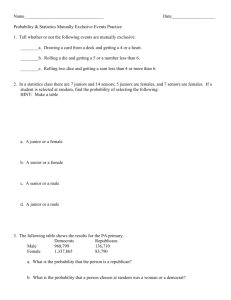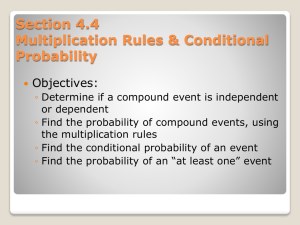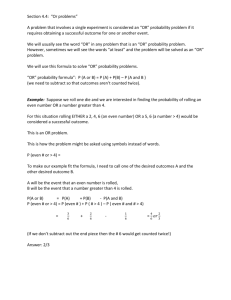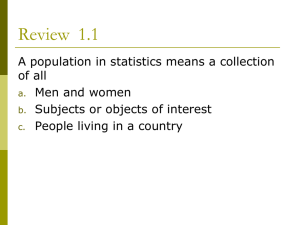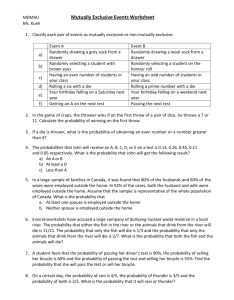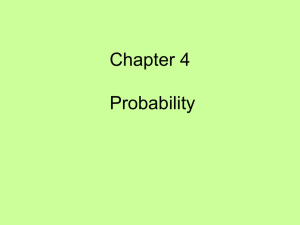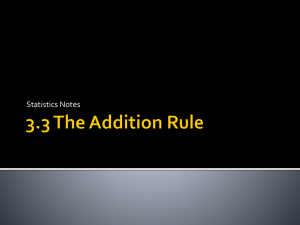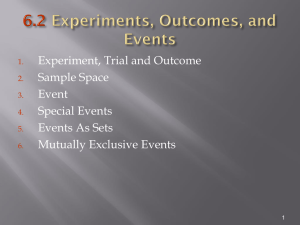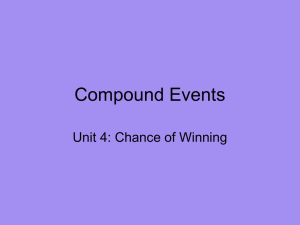Probability Rules
advertisement
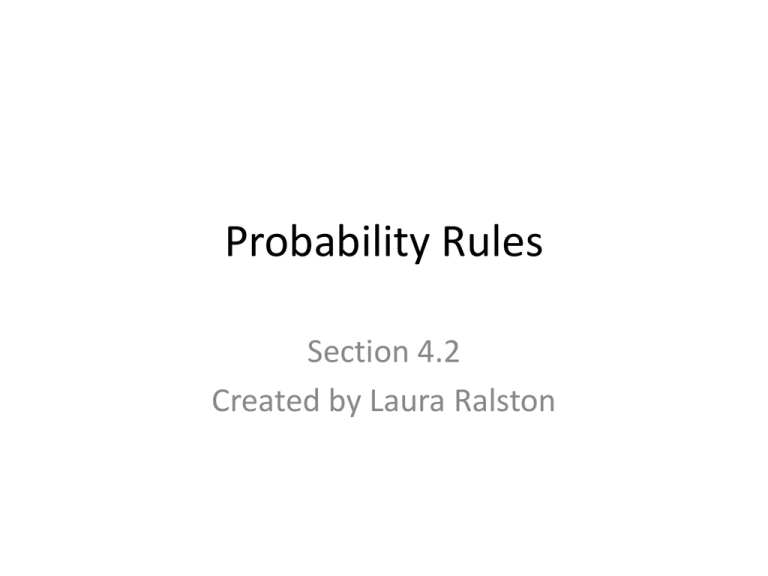
Probability Rules Section 4.2 Created by Laura Ralston 4 Basic Probability Rules • Probability of any event E is a number (fraction or decimal) between and including 0 and 1 • 0 < P(E) < 1 • If an event E cannot occur, its probability is 0 • P(impossible event) =0 The Complement • The complement of event E, denoted Ec, consists of all outcomes in the sample space that are NOT in event E. • Example: If the experiment is rolling a die and event E is rolling a 5, then the complement of event E is NOT rolling a 5 (1, 2, 3, 4, 6). • P(E) + P(Ec) = 1 or P(Ec) = 1- P(E) 4 Basic Probability Rules • If event E is certain to occur, then the probability is 1. • P(definitely happening event) = 1 • The sum of the probabilities of all the outcomes in the sample space is 1. Addition Rule for Probability RECALL: Compound Event: any event containing two or more simple events KEY WORD: OR In mathematics, we use an “inclusive” or Either one or the other or BOTH Example: If I ask for a bologna or cheese sandwich, you could give me a sandwich with Just bologna Just cheese Bologna and cheese To determine the probability of a compound event involving OR, we must first determine if the two events are mutually exclusive Mutually Exclusive Two events are mutually exclusive if they cannot occur at the same time (i.e. They have no outcomes in common Event A and B Event A Event B NOT Mutually Exclusive Mutually Exclusive Event A Event B Examples At a large political gathering, you select a person at random to determine if the person is a Republican or female At a large political gathering, you select a person at random to determine if the person is a Democrat or Independent Flip a coin to determine if you get a head or tail Roll a die to determine if you get a 4 or 6 Roll a die to determine if you get 3 or an odd number Draw a card from a standard deck to determine if you get a queen and a heart Draw a card from a standard deck to determine if you get a black card or a diamond Addition Rules Events are Mutually Exclusive P(A or B) = P(A) +P(B) Events are NOT Mutually Exclusive P(A or B) = P(A) + P(B) – P(A and B) Group Type 0 A B AB Rh + 39 35 8 4 Rh - 6 5 2 1 If one person is randomly selected, find the probability P(person is not group A) P( person has type Rh -) P(person is group A or type Rh -) P(person is group A or group B) P(person is not type Rh +) P(person is group B or type Rh +) P(person is group AB or type Rh +) P(person is group A or group O or type Rh+) Multiplication Rule for Probability • RECALL: Compound Event: any event containing two or more simple events • KEY WORD: AND – Two or more events occur in sequence – If a coin is tossed and then a die is rolled, you can find the probability of getting a head on the coin and a 4 on the die – If two dice are rolled, you can find the probability of getting a 6 on the first die and getting a 3 on the second die To determine the probability of a compound event involving AND, we must first determine if the two events are independent or dependent Independent vs Dependent Independent Dependent • Two events A and B are independent if the fact that A occurs does not affect the probability of B occurring When the outcome of the first event A affects the outcome or occurrence of the second event B in such a way that the probability is changed, the events are said to be dependent. • “With Replacement” • “With Repetition” “Without replacement” “Without repetition” Examples • Drawing a card from a standard deck and getting a queen, replacing it, and drawing a second card and getting a queen • An drawer contains 3 red socks, 2 blue socks, and 5 white socks. A sock is selected and its color is noted. A second sock is selected and its color noted. • Being a lifeguard and getting a suntan • Randomly selecting a TV viewer who is watching “Friends”. Randomly selecting a second TV viewer who is watching “Friends” Multiplication Rules Independent Events Dependent Events P(A and B) = P(A) ∙ P(B) P(A and B) = P(A) ∙ P(B|A) To find the probability of two independent events that occur in sequence, find the probability of each event separately and then multiply the answers. To find the probability of two dependent events that occur in sequence, find the probability of the first event, then “adjust” the probability of the second event based on the fact that the first has occurred, and then multiply the answers. Examples Draw two cards with replacement from a standard deck. Find P(Queen and Queen) An drawer contains 3 red socks, 2 blue socks, and 5 white socks. Two socks are selected without replacement. Find P(White and Red) A new computer owner creates a password consisting of two characters. She randomly selects a letter of the alphabet for the first character and a digit (0-9) for the second character. What is the probability that her password is “K9”? Would this password be an effective deterrent to a hacker? In the 108th Congress, the Senate consisted of 51 Republicans, 48 Democrats, and 1 Independent. If a lobbyist for the tobacco industry randomly selects three different Senators, what is the probability that they are all Republicans? That is P(Republican and Republican and Republican). Conditional Probability • The probability of the second event B should take into account the fact that the first event A has already occurred • KEY WORDS: GIVEN THAT • P(B|A) = (formula) – Logic is easier Republican Democrat Independent Male 46 39 1 Female 5 9 0 If we randomly select one Senator, find the probability P(Republican given that a male is selected) P(Male given that a Republican is selected) P(Female given that an Independent was selected) P(Democrat or Independent given that a male is selected) “At Least One” Probability • “At least one” is equivalent to “one or more” • The complement (not) of getting at least one item of a particular type is that you get NO items of that type • To calculate the probability of “at least one” of something, calculate the probability of NONE, then subtract the result from 1. P(at least one) = 1 – P(none) Examples If a couple plans to have 10 children (it could happen), what is the probability that there will be at least one girl? In acceptance sampling, a sample of items is randomly selected without replacement and the entire batch is rejected if there is at least one defect. The Medtyme Company just manufactured 5000 blood pressure monitors and 4% are defective. If 3 of the monitors are selected at random and tested, what is the probability that the entire batch will be rejected? Assignment • p. 171 #1-37 odd
